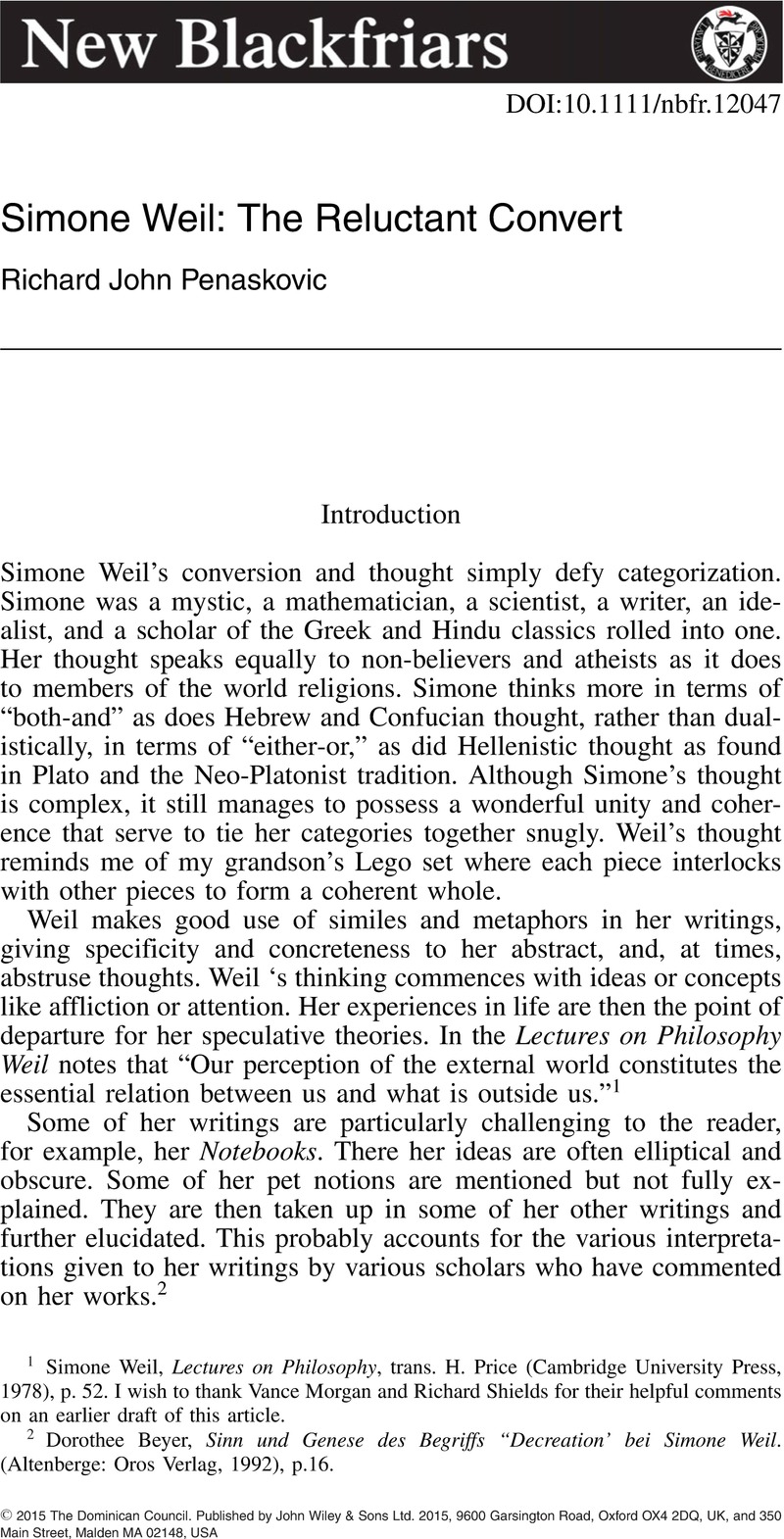No CrossRef data available.
Published online by Cambridge University Press: 01 January 2024

1 Weil, Simone, Lectures on Philosophy, trans. Price, H. (Cambridge University Press, 1978), p. 52CrossRefGoogle Scholar. I wish to thank Vance Morgan and Richard Shields for their helpful comments on an earlier draft of this article.
2 Beyer, Dorothee, Sinn und Genese des Begriffs “Decreation’ bei Simone Weil. (Altenberge: Oros Verlag, 1992), p.16Google Scholar.
3 Weil, Simone, Waiting on God. trans. Craufurd, Emma (New York: Harper Colophon Books, 1951), p. 13Google Scholar.
4 Berry, Thomas, Religions of India: Hinduism, Yoga, Buddhism, (Chambersberg, PA: Anima Publications, 1992), p. 33Google Scholar.
5 Weil, Simone, Gravity and Grace, trans. Wills, Arthur (New York: Octagon Books, 1979) p. 173Google Scholar.
6 Springsted, Eric O., Simone Weil (Maryknoll, N.Y.: Orbis, 1998) pp. 71–74Google Scholar.
7 Gravity and Grace, p. 96.
8 Ibid., p. 20.
9 Ibid., p. 21.
10 Ibid., p. 93.
11 Springsted, pp. 42–43.
12 Ibid., p. 83.
13 Gravity and Grace, p. 78.
14 Ibid., p. 80.
15 Ibid., p. 81.
16 Ibid., p. 82.
17 Ibid., p. 83.
18 Ibid., p. 83.
19 Ibid., p. 86. See Maskulak, Marian, “Edith Stein and Simone Weil: Reflections for a Spirituality of the Cross, “ Theology Today 364 (2008), 445–457CrossRefGoogle Scholar and Morgan, Vance G., Weaving The World: Simone Weil On Science, Mathematics, And Love (Notre Dame, IN: University of N.D. Press, 2005), pp. 159–171Google Scholar.
20 Pirruccello, Ann, “Gravity in the Thought of Simone Weil,” Philosophy and Phenomenological Research 57 (2009), p. 73CrossRefGoogle Scholar.
21 Gravity and Grace, p. 88.
22 Ibid., p. 88.
23 Waiting on God, p. 32.
24 Ibid., p. 32.
25 Ibid., p. 34.
26 Ibid., p. 36.
27 Ibid., p. 36.
28 Penaskovic, Richard, “Saint Augustine’ Confessions and Newman's Apologia: Similarities and Differences,” Augustinian Studies 9 (1978), pp. 81–91CrossRefGoogle Scholar.
29 Waiting on God, p. 36.
30 Ibid., p. 36.
31 Ibid., p. 38.
32 Ibid., p. 39.
33 Ibid., p. 40.
34 Ibid., p. 41.
35 Ibid., p. 41.
36 Ibid., p. 43.
37 Ibid., p. 44.
38 Ibid., p. 46.
39 Ibid., p. 47.
40 Ibid., p. 47.
41 Ibid., p. 48.
42 Beyer, Sinn und Genese, p. 17.
43 Ibid., p. 19.
44 D'Costa, Gavin, “ Theology of Religions,” in Ford, David F., ed., The Modern Theologians :An Introduction to Christian Theology in the Twentieth Century (Oxford: Blackwell, 1997), pp. 626–644Google Scholar.
45 Muhlen, Heribert, Una Mystica Persona: Die Kirche als das Mysterium der Identitat des Heiligen Geiste in Christus und den Christen (Wuerzburg: Ferdinand Schoningh, 1968)Google Scholar.